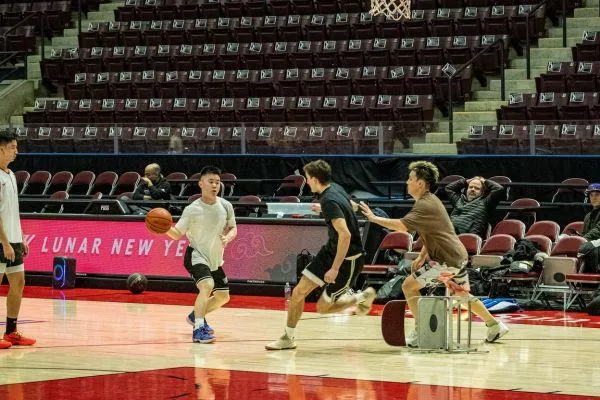
The Problem with Traditional Basketball Drills (And How to Fix It)
The Problem with Traditional Basketball Drills (And How to Fix It)
If you walk into any gym, you’ll probably see players doing the same drills that have been used for decades—dribbling through cones, shooting from fixed spots, running full-speed layups with no defender.
These drills look productive, but they don’t actually prepare players for real games.
Basketball is not a scripted sport. Every play is different. Defenders react, spacing changes, and players have to make split-second decisions. Yet, most training is built around predictable, isolated drills that remove all of that chaos.
For players in Oakville and beyond, understanding why traditional drills fail is the first step in fixing them.
1. Isolated Drills Don’t Build Real Game Skills
Most traditional drills focus on repetition over realism. Players practice moves in perfect conditions, but when the game starts, those conditions don’t exist.
🚨 The Problem:
•A player works on their crossover against cones, but in a game, defenders move, reach, and adjust.
•A shooter drills catch-and-shoot jumpers, but in real play, they might have to adjust their shot based on a closeout.
•A guard practices driving in a straight line, but in games, the lane is crowded, and help defense rotates.
✅ The Fix:
•Train against live defenders. If a move only works in an open gym, it won’t work in a game.
•Add variability to drills. Instead of shooting from the same spot, mix in different speeds, angles, and contests.
•Make every drill game-relevant. If a player won’t use a move in real competition, it’s not worth practicing.
2. Traditional Drills Teach Players What to Do, But Not When to Do It
Most training focuses on moves, not decisions. Players are taught a series of actions—crossover, pull-up, step-back—but not how to read the defense and know when to use them.
🚨 The Problem:
•Players memorize moves but don’t learn how to react in real time.
•When the defense takes away their first option, they hesitate instead of adjusting.
•They practice skills in a vacuum instead of developing instincts through live play.
✅ The Fix:
•Include decision-making in drills. Instead of telling a player what move to use, create a situation where they have to read and react.
•Use small-sided games (2v2, 3v3). These force players to make quick decisions in game-like situations.
•Focus on problem-solving, not memorization. Basketball is about making the right read, not running a pre-planned move.
3. Cone Drills Don’t Prepare Players for Real Defense
It’s easy to look smooth when dribbling around cones. It’s a lot harder when there’s a real defender applying pressure.
🚨 The Problem:
•Cones don’t move. Defenders do.
•Players get used to executing moves without any resistance.
•Training without defense doesn’t teach how to handle contact, anticipate reach-ins, or change pace under pressure.
✅ The Fix:
•Replace cones with guided defenders. Even light defensive pressure forces players to react.
•Train finishing through contact. Add a coach or teammate challenging shots at the rim.
•Use constraints-led drills. If a player struggles beating defenders off the dribble, create a drill where they have to score in a one-on-one with limited dribbles.
4. Players Train at the Wrong Speed
Many traditional drills are either too slow and controlled or too rushed and unrealistic.
🚨 The Problem:
•If drills are too slow, players don’t learn how to execute at game speed.
•If drills are too fast, players lose technique and develop sloppy habits.
•The game requires players to switch speeds—most drills don’t train that skill.
✅ The Fix:
•Start slow, then speed up. Focus on technique first, then add defensive pressure.
•Train different speeds. Players should learn to change pace—slowing down, then exploding past defenders.
•Use time constraints. Instead of telling a player to “go fast,” give them a set time to react and execute.
5. Shooting Drills Don’t Mimic Real Shots
A lot of training emphasizes perfect, controlled shooting reps, but in a game, shots are rarely perfect.
🚨 The Problem:
•Players practice wide-open shots but struggle when shooting off movement.
•They get comfortable in workouts but panic when facing real defensive pressure.
•They don’t train for quick releases, different footwork, or contested shots.
✅ The Fix:
•Shoot under pressure. Every drill should include a defender closing out or contesting.
•Replicate real game shots. Instead of standing still, players should practice shooting off the dribble, off the catch, and off screens.
•Use variable shooting drills. Change the distance, angle, and pass type to force adjustments.
What Basketball Training Needs to Look Like
Basketball is unpredictable. Players need training that prepares them for that unpredictability.
✅ Drills must involve decision-making. Every rep should force players to read and react.
✅ Skills should be tested in live play. If a move doesn’t work in a scrimmage, it won’t work in a game.
✅ Training should be uncomfortable. The best way to improve is by constantly challenging adaptability.
Why This Matters for Players in Oakville
If you’re looking for basketball training in Oakville, make sure the program prioritizes real-game skill development, not just rehearsed drills. A lot of training looks great on Instagram but doesn’t actually help players improve where it matters—in real games, against real defenders.
At By Any Means Basketball, we focus on game-realistic training. Every workout is designed to develop skills that translate under pressure, in live competition, and in unpredictable situations.
Final Thoughts: How to Fix Basketball Training
If a player spends hours in the gym but struggles in games, the problem isn’t effort—it’s the way they’re training.
✔ Are you training for real competition, or just for workouts?
✔ Are you developing skills that hold up under pressure, or just looking smooth in drills?
✔ Are you learning decision-making, or just memorizing moves?
If your training doesn’t prepare you for game-speed reads, real defensive pressure, and unpredictable situations, it’s not doing its job. The best training is uncomfortable, challenging, and forces you to adapt—because that’s exactly what happens in real games.